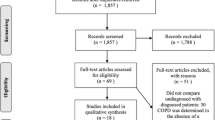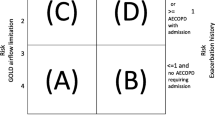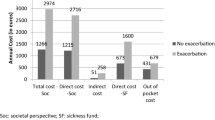Abstract
Global Initiative on Chronic Obstructive Lung Disease (GOLD) guidelines recently removed stage 0, a group with symptoms but without airways obstruction, from their severity staging. However, in practice this group may still be diagnosed and medically managed. The aim of this study was to characterize healthcare utilization patterns of chronic obstructive pulmonary disease (COPD) patients by disease severity, focusing on the possible unique attributes of patients who would have been classified as GOLD stage 0. This is a prospective cohort pilot study performed at the Hines Veterans Administration Hospital. One hundred twenty patients with a diagnosis of COPD were enrolled. The participants completed quality-of-life questionnaires and a pulmonary function test. Healthcare utilization data were obtained 1 year prior and 2 years after the enrollment date. Three disease severity groups were defined based on GOLD criteria for comparison [GOLD stage 1–2 (GS 1–2), GOLD stage 3–4 (GS 3–4), and formerly GOLD stage 0 (“at risk”)]. The “at risk” group had an average of 14.4 (SD = 30.5) outpatient visits/year and 0.3 (SD = 0.8) hospitalizations/year, which were higher than the other groups, but this was not statistically significant. Respiratory medications were used by 6 (26%), 30 (59%), and 40 (91%) patients from “at risk” to GS 3–4, respectively. Patients in the “at risk” group had a decrement in health status, significant utilization of healthcare services, and were often receiving medications not consistent with guidelines.
Similar content being viewed by others
References
Morbidity & Mortality (2007) Chart book on cardiovascular, lung, and blood diseases. National Institutes of Health, National Heart, Lung, and Blood Institute, Bethesda, MD
Global Inititiative for Chronic Obstructive Lung Disease. Global strategy for the diagnosis, management and prevention of chronic obstructive pulmonary disease (updated 2006). http://www.goldcopd.org/Guidelineitem.asp?l1=2&l2=1&intId=989. Accessed 1 December 2007
Han MK, Kim MG, Mardon R, Renner P, Sullivan S, Diette GB, Martinez FJ (2007) Spirometry utilization for COPD: how do we measure up? Chest 132:403–409
Lee TA, Bartle B, Weiss KB (2006) Spirometry use in clinical practice following diagnosis of COPD. Chest 129:1509–1515
Agency for Healthcare Research and Quality (2005) Use of spirometry for case finding, diagnosis and management of chronic obstructive pulmonary disease (COPD). www.ohrq.gov/downloads/pud/evidence/pdf/spirocopd/spiro.pdf. Accessed 1 December 2007
Mannino DM, Gagnon RC, Petty TL, Lydick E (2000) Obstructive lung disease and low lung function in adults in the United States: data from the National Health and Nutrition Examination Survey, 1988–1994. Arch Intern Med 160:1683–1689
Antonelli-Incalzi R, Imperiale C, Bellia V, Catalano F, Scichilone N, Pistelli R, Rengo F (2003) Do GOLD stages of COPD severity really correspond to differences in health status? Eur Respir J 22:444–449
Enright PL, Crapo RO (2000) Controversies in the use of spirometry for early recognition and diagnosis of chronic obstructive pulmonary disease in cigarette smokers. Clin Chest Med 21:645–652
Lindberg A, Eriksson B, Larsson LG, Ronmark E, Sandstrom T, Lundback B (2006) Seven-year cumulative incidence of COPD in an age-stratified general population sample. Chest 129:879–885
Lindberg A, Jonsson AC, Ronmark E, Lundgren R, Larsson LG, Lundback B (2005) Ten-year cumulative incidence of COPD and risk factors for incident disease in a symptomatic cohort. Chest 127:1544–1552
Vestbo J, Lange P (2002) Can GOLD Stage 0 provide information of prognostic value in chronic obstructive pulmonary disease? Am J Respir Crit Care Med 166:329–332
Ekberg-Aronsson M, Pehrsson K, Nilsson JA, Nilsson PM, Lofdahl CG (2005) Mortality in GOLD stages of COPD and its dependence on symptoms of chronic bronchitis. Respir Res 6:98
Ferrer M, Alonso J, Morera J, Marrades RM, Khalaf A, Aguar MC, Plaza V, Prieto L, Anto JM (1997) Chronic obstructive pulmonary disease stage and health-related quality of life. The Quality of Life of Chronic Obstructive Pulmonary Disease Study Group. Ann Intern Med 127:1072–1079
Mannino DM, Doherty DE, Sonia Buist A (2006) Global Initiative on Obstructive Lung Disease (GOLD) classification of lung disease and mortality: findings from the Atherosclerosis Risk in Communities (ARIC) study. Respir Med 100:115–122
Stavem K, Sandvik L, Erikssen J (2006) Can global initiative for Chronic Obstructive Lung Disease stage 0 provide prognostic information on long-term mortality in men? Chest 130:318–325
Jones PW, Quirk FH, Baveystock CM (1991) The St George’s Respiratory Questionnaire. Respir Med 85 Suppl B:25–31; discussion 33–27
Barr JT, Schumacher GE, Freeman S, LeMoine M, Bakst AW, Jones PW (2000) American translation, modification, and validation of the St. George’s Respiratory Questionnaire. Clin Ther 22:1121–1145
Jones PW, Quirk FH, Baveystock CM, Littlejohns P (1992) A self-complete measure of health status for chronic airflow limitation. The St. George’s Respiratory Questionnaire. Am Rev Respir Dis 145:1321–1327
Rutten-van Molken M, Roos B, Van Noord JA (1999) An empirical comparison of the St. George’s Respiratory Questionnaire (SGRQ) and the Chronic Respiratory Disease Questionnaire (CRQ) in a clinical trial setting. Thorax 54:995–1003
Kleinbaum DG, Kupper LL, Muller KE, Nizam A (1988) Applied Regression Analysis and Other Multivariate Methods. Brooks/Cole Publishing Company, Pacific Grove, CA, pp 451–457
Stahl E, Lindberg A, Jansson SA, Ronmark E, Svensson K, Andersson F, Lofdahl CG, Lundback B (2005) Health-related quality of life is related to COPD disease severity. Health Qual Life Outcomes 3:56
Acknowledgments
This study was partly funded by an unrestricted research grant from Boehringer-Ingelheim Pharmaceuticals. This material was also based upon work supported by the HSR&D Service, Center for Management of Complex Chronic Care COE, Hines VA Hospital. The funding agency had no role in the design, conduct, or interpretation of the study results. Kevin Weiss was the Director for the Management of Complex Chronic Care, Hines VA Hospital, Hines, IL, and the Institute for Healthcare Studies at Northwestern University Feinberg School of Medicine, Chicago, IL, when this work was performed. This work was performed while all authors were employees of the Hines Veterans Administration Hospital. As U.S. government employees, this article was made in that capacity, thus assignment applies only to the extent allowable by U.S. law.
Author information
Authors and Affiliations
Corresponding author
Rights and permissions
About this article
Cite this article
Joo, M.J., Lee, T.A., Bartle, B. et al. Patterns of Healthcare Utilization by COPD Severity: A Pilot Study. Lung 186, 307–312 (2008). https://doi.org/10.1007/s00408-008-9095-5
Received:
Accepted:
Published:
Issue Date:
DOI: https://doi.org/10.1007/s00408-008-9095-5




